Wollega University MBA Marketing Management Book Review Report
VerifiedAdded on 2020/10/09
|68
|20123
|221
Report
AI Summary
This report is a book review of "Principle of Marketing Management" by Philip Kotler, Veronica Wong, John Saunders, and Gary Armstrong, prepared by a student from Wollega University's MBA program. The review covers the core concepts of marketing including needs, wants, demands, products, value, satisfaction, exchange, and markets. It explores customer value, satisfaction, and quality, the marketing management philosophies, and the marketing process. The report also delves into strategic marketing, including strategic planning, the business portfolio, market segmentation, targeting, positioning, and the marketing mix (product, price, place, and promotion). The marketing environment (micro and macro), marketing research, relationship marketing, and competitive strategy are also discussed. The review highlights the importance of strategic marketing partners, the marketing environment, and the four marketing management functions: analysis, planning, implementation, and control. The report concludes with a discussion of marketing ROI.
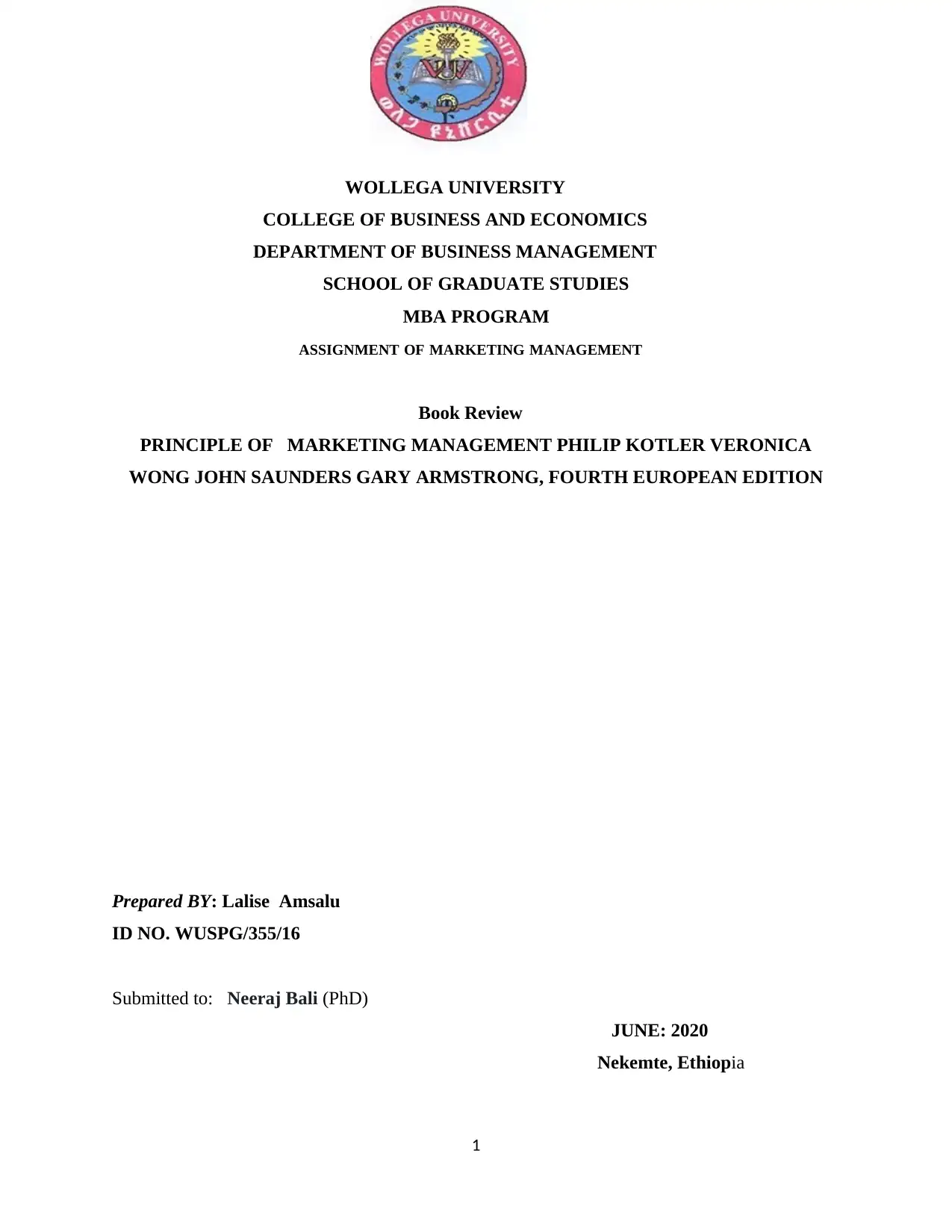
WOLLEGA UNIVERSITY
COLLEGE OF BUSINESS AND ECONOMICS
DEPARTMENT OF BUSINESS MANAGEMENT
SCHOOL OF GRADUATE STUDIES
MBA PROGRAM
ASSIGNMENT OF MARKETING MANAGEMENT
Book Review
PRINCIPLE OF MARKETING MANAGEMENT PHILIP KOTLER VERONICA
WONG JOHN SAUNDERS GARY ARMSTRONG, FOURTH EUROPEAN EDITION
Prepared BY: Lalise Amsalu
ID NO. WUSPG/355/16
Submitted to: Neeraj Bali (PhD)
JUNE: 2020
Nekemte, Ethiopia
1
COLLEGE OF BUSINESS AND ECONOMICS
DEPARTMENT OF BUSINESS MANAGEMENT
SCHOOL OF GRADUATE STUDIES
MBA PROGRAM
ASSIGNMENT OF MARKETING MANAGEMENT
Book Review
PRINCIPLE OF MARKETING MANAGEMENT PHILIP KOTLER VERONICA
WONG JOHN SAUNDERS GARY ARMSTRONG, FOURTH EUROPEAN EDITION
Prepared BY: Lalise Amsalu
ID NO. WUSPG/355/16
Submitted to: Neeraj Bali (PhD)
JUNE: 2020
Nekemte, Ethiopia
1
Paraphrase This Document
Need a fresh take? Get an instant paraphrase of this document with our AI Paraphraser
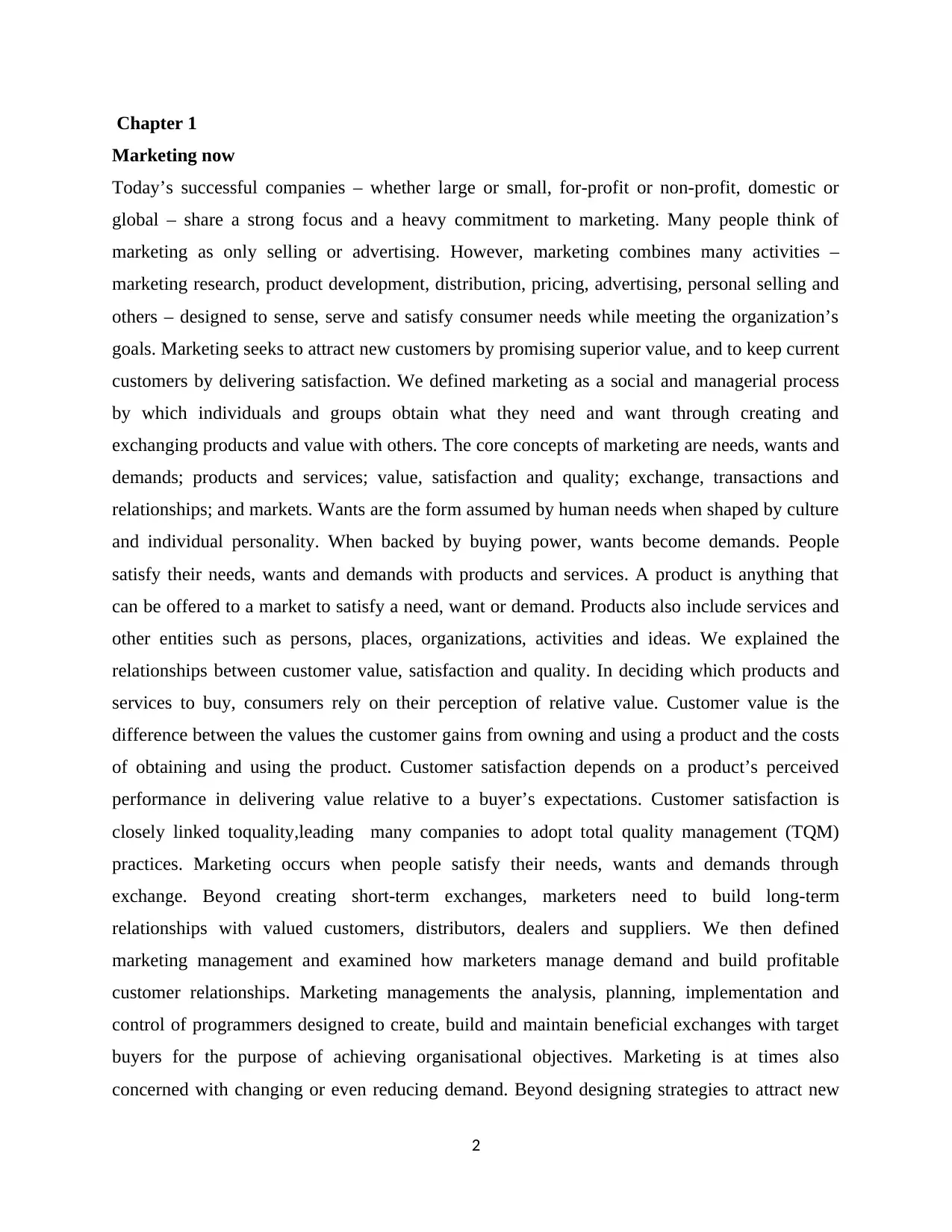
Chapter 1
Marketing now
Today’s successful companies – whether large or small, for-profit or non-profit, domestic or
global – share a strong focus and a heavy commitment to marketing. Many people think of
marketing as only selling or advertising. However, marketing combines many activities –
marketing research, product development, distribution, pricing, advertising, personal selling and
others – designed to sense, serve and satisfy consumer needs while meeting the organization’s
goals. Marketing seeks to attract new customers by promising superior value, and to keep current
customers by delivering satisfaction. We defined marketing as a social and managerial process
by which individuals and groups obtain what they need and want through creating and
exchanging products and value with others. The core concepts of marketing are needs, wants and
demands; products and services; value, satisfaction and quality; exchange, transactions and
relationships; and markets. Wants are the form assumed by human needs when shaped by culture
and individual personality. When backed by buying power, wants become demands. People
satisfy their needs, wants and demands with products and services. A product is anything that
can be offered to a market to satisfy a need, want or demand. Products also include services and
other entities such as persons, places, organizations, activities and ideas. We explained the
relationships between customer value, satisfaction and quality. In deciding which products and
services to buy, consumers rely on their perception of relative value. Customer value is the
difference between the values the customer gains from owning and using a product and the costs
of obtaining and using the product. Customer satisfaction depends on a product’s perceived
performance in delivering value relative to a buyer’s expectations. Customer satisfaction is
closely linked toquality,leading many companies to adopt total quality management (TQM)
practices. Marketing occurs when people satisfy their needs, wants and demands through
exchange. Beyond creating short-term exchanges, marketers need to build long-term
relationships with valued customers, distributors, dealers and suppliers. We then defined
marketing management and examined how marketers manage demand and build profitable
customer relationships. Marketing managements the analysis, planning, implementation and
control of programmers designed to create, build and maintain beneficial exchanges with target
buyers for the purpose of achieving organisational objectives. Marketing is at times also
concerned with changing or even reducing demand. Beyond designing strategies to attract new
2
Marketing now
Today’s successful companies – whether large or small, for-profit or non-profit, domestic or
global – share a strong focus and a heavy commitment to marketing. Many people think of
marketing as only selling or advertising. However, marketing combines many activities –
marketing research, product development, distribution, pricing, advertising, personal selling and
others – designed to sense, serve and satisfy consumer needs while meeting the organization’s
goals. Marketing seeks to attract new customers by promising superior value, and to keep current
customers by delivering satisfaction. We defined marketing as a social and managerial process
by which individuals and groups obtain what they need and want through creating and
exchanging products and value with others. The core concepts of marketing are needs, wants and
demands; products and services; value, satisfaction and quality; exchange, transactions and
relationships; and markets. Wants are the form assumed by human needs when shaped by culture
and individual personality. When backed by buying power, wants become demands. People
satisfy their needs, wants and demands with products and services. A product is anything that
can be offered to a market to satisfy a need, want or demand. Products also include services and
other entities such as persons, places, organizations, activities and ideas. We explained the
relationships between customer value, satisfaction and quality. In deciding which products and
services to buy, consumers rely on their perception of relative value. Customer value is the
difference between the values the customer gains from owning and using a product and the costs
of obtaining and using the product. Customer satisfaction depends on a product’s perceived
performance in delivering value relative to a buyer’s expectations. Customer satisfaction is
closely linked toquality,leading many companies to adopt total quality management (TQM)
practices. Marketing occurs when people satisfy their needs, wants and demands through
exchange. Beyond creating short-term exchanges, marketers need to build long-term
relationships with valued customers, distributors, dealers and suppliers. We then defined
marketing management and examined how marketers manage demand and build profitable
customer relationships. Marketing managements the analysis, planning, implementation and
control of programmers designed to create, build and maintain beneficial exchanges with target
buyers for the purpose of achieving organisational objectives. Marketing is at times also
concerned with changing or even reducing demand. Beyond designing strategies to attract new
2
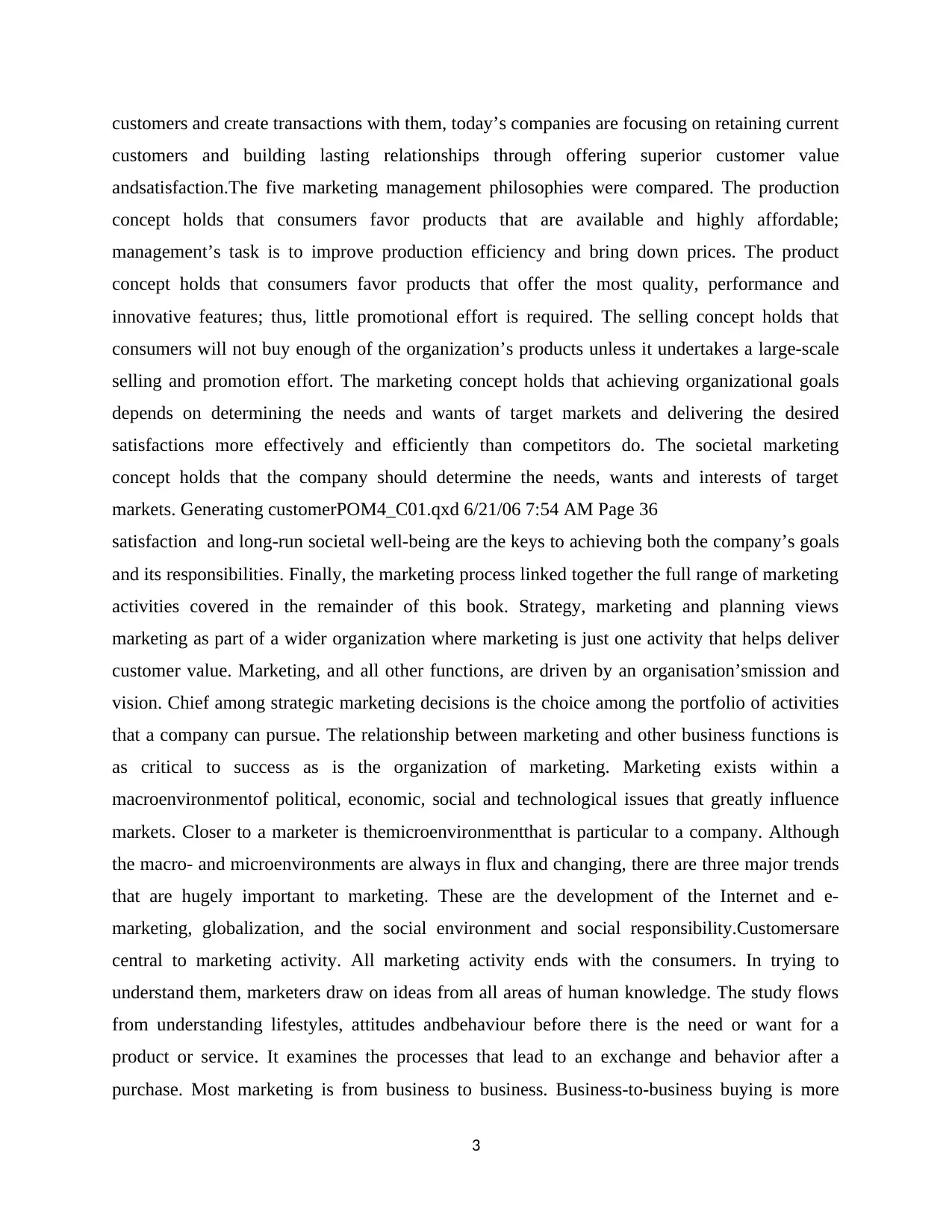
customers and create transactions with them, today’s companies are focusing on retaining current
customers and building lasting relationships through offering superior customer value
andsatisfaction.The five marketing management philosophies were compared. The production
concept holds that consumers favor products that are available and highly affordable;
management’s task is to improve production efficiency and bring down prices. The product
concept holds that consumers favor products that offer the most quality, performance and
innovative features; thus, little promotional effort is required. The selling concept holds that
consumers will not buy enough of the organization’s products unless it undertakes a large-scale
selling and promotion effort. The marketing concept holds that achieving organizational goals
depends on determining the needs and wants of target markets and delivering the desired
satisfactions more effectively and efficiently than competitors do. The societal marketing
concept holds that the company should determine the needs, wants and interests of target
markets. Generating customerPOM4_C01.qxd 6/21/06 7:54 AM Page 36
satisfaction and long-run societal well-being are the keys to achieving both the company’s goals
and its responsibilities. Finally, the marketing process linked together the full range of marketing
activities covered in the remainder of this book. Strategy, marketing and planning views
marketing as part of a wider organization where marketing is just one activity that helps deliver
customer value. Marketing, and all other functions, are driven by an organisation’smission and
vision. Chief among strategic marketing decisions is the choice among the portfolio of activities
that a company can pursue. The relationship between marketing and other business functions is
as critical to success as is the organization of marketing. Marketing exists within a
macroenvironmentof political, economic, social and technological issues that greatly influence
markets. Closer to a marketer is themicroenvironmentthat is particular to a company. Although
the macro- and microenvironments are always in flux and changing, there are three major trends
that are hugely important to marketing. These are the development of the Internet and e-
marketing, globalization, and the social environment and social responsibility.Customersare
central to marketing activity. All marketing activity ends with the consumers. In trying to
understand them, marketers draw on ideas from all areas of human knowledge. The study flows
from understanding lifestyles, attitudes andbehaviour before there is the need or want for a
product or service. It examines the processes that lead to an exchange and behavior after a
purchase. Most marketing is from business to business. Business-to-business buying is more
3
customers and building lasting relationships through offering superior customer value
andsatisfaction.The five marketing management philosophies were compared. The production
concept holds that consumers favor products that are available and highly affordable;
management’s task is to improve production efficiency and bring down prices. The product
concept holds that consumers favor products that offer the most quality, performance and
innovative features; thus, little promotional effort is required. The selling concept holds that
consumers will not buy enough of the organization’s products unless it undertakes a large-scale
selling and promotion effort. The marketing concept holds that achieving organizational goals
depends on determining the needs and wants of target markets and delivering the desired
satisfactions more effectively and efficiently than competitors do. The societal marketing
concept holds that the company should determine the needs, wants and interests of target
markets. Generating customerPOM4_C01.qxd 6/21/06 7:54 AM Page 36
satisfaction and long-run societal well-being are the keys to achieving both the company’s goals
and its responsibilities. Finally, the marketing process linked together the full range of marketing
activities covered in the remainder of this book. Strategy, marketing and planning views
marketing as part of a wider organization where marketing is just one activity that helps deliver
customer value. Marketing, and all other functions, are driven by an organisation’smission and
vision. Chief among strategic marketing decisions is the choice among the portfolio of activities
that a company can pursue. The relationship between marketing and other business functions is
as critical to success as is the organization of marketing. Marketing exists within a
macroenvironmentof political, economic, social and technological issues that greatly influence
markets. Closer to a marketer is themicroenvironmentthat is particular to a company. Although
the macro- and microenvironments are always in flux and changing, there are three major trends
that are hugely important to marketing. These are the development of the Internet and e-
marketing, globalization, and the social environment and social responsibility.Customersare
central to marketing activity. All marketing activity ends with the consumers. In trying to
understand them, marketers draw on ideas from all areas of human knowledge. The study flows
from understanding lifestyles, attitudes andbehaviour before there is the need or want for a
product or service. It examines the processes that lead to an exchange and behavior after a
purchase. Most marketing is from business to business. Business-to-business buying is more
3
⊘ This is a preview!⊘
Do you want full access?
Subscribe today to unlock all pages.

Trusted by 1+ million students worldwide
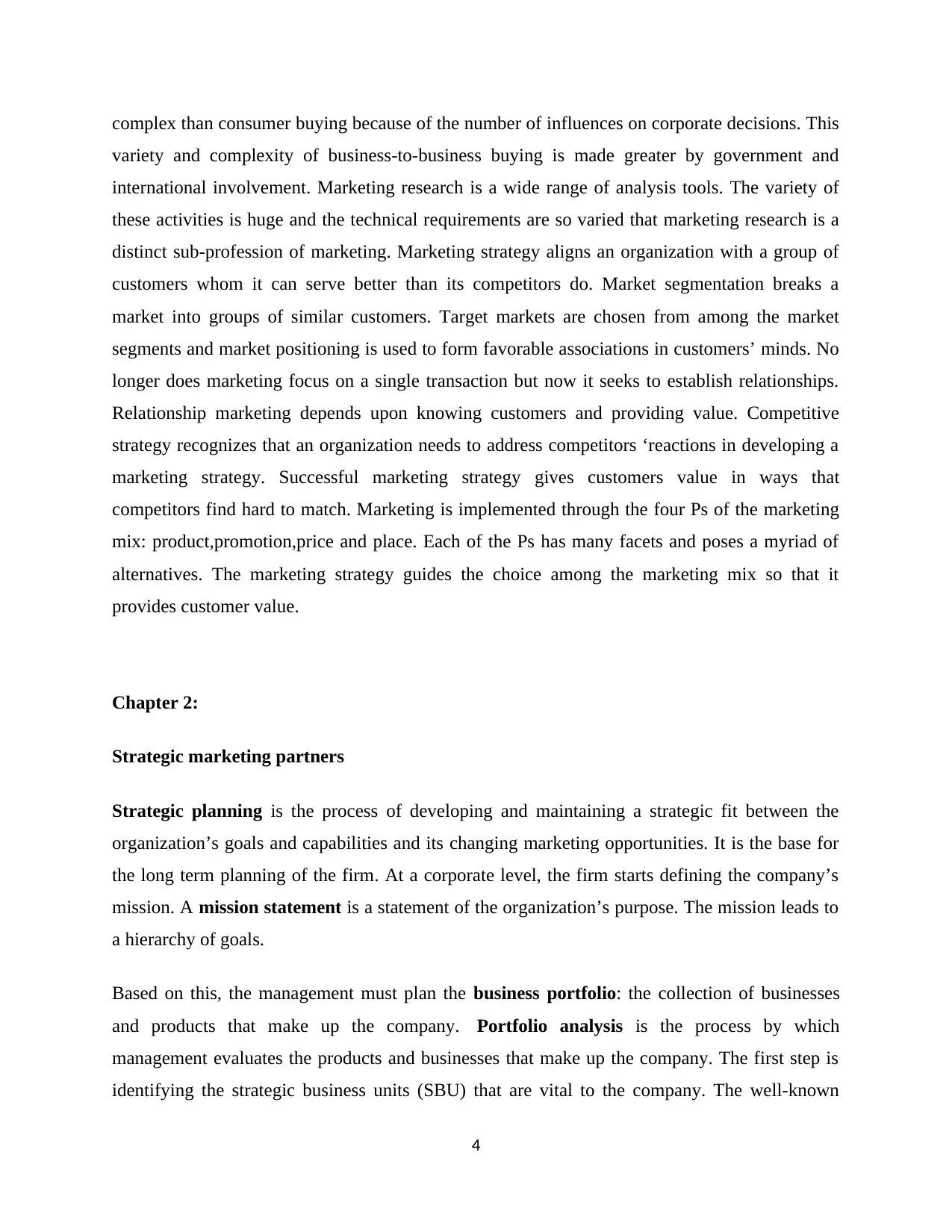
complex than consumer buying because of the number of influences on corporate decisions. This
variety and complexity of business-to-business buying is made greater by government and
international involvement. Marketing research is a wide range of analysis tools. The variety of
these activities is huge and the technical requirements are so varied that marketing research is a
distinct sub-profession of marketing. Marketing strategy aligns an organization with a group of
customers whom it can serve better than its competitors do. Market segmentation breaks a
market into groups of similar customers. Target markets are chosen from among the market
segments and market positioning is used to form favorable associations in customers’ minds. No
longer does marketing focus on a single transaction but now it seeks to establish relationships.
Relationship marketing depends upon knowing customers and providing value. Competitive
strategy recognizes that an organization needs to address competitors ‘reactions in developing a
marketing strategy. Successful marketing strategy gives customers value in ways that
competitors find hard to match. Marketing is implemented through the four Ps of the marketing
mix: product,promotion,price and place. Each of the Ps has many facets and poses a myriad of
alternatives. The marketing strategy guides the choice among the marketing mix so that it
provides customer value.
Chapter 2:
Strategic marketing partners
Strategic planning is the process of developing and maintaining a strategic fit between the
organization’s goals and capabilities and its changing marketing opportunities. It is the base for
the long term planning of the firm. At a corporate level, the firm starts defining the company’s
mission. A mission statement is a statement of the organization’s purpose. The mission leads to
a hierarchy of goals.
Based on this, the management must plan the business portfolio: the collection of businesses
and products that make up the company. Portfolio analysis is the process by which
management evaluates the products and businesses that make up the company. The first step is
identifying the strategic business units (SBU) that are vital to the company. The well-known
4
variety and complexity of business-to-business buying is made greater by government and
international involvement. Marketing research is a wide range of analysis tools. The variety of
these activities is huge and the technical requirements are so varied that marketing research is a
distinct sub-profession of marketing. Marketing strategy aligns an organization with a group of
customers whom it can serve better than its competitors do. Market segmentation breaks a
market into groups of similar customers. Target markets are chosen from among the market
segments and market positioning is used to form favorable associations in customers’ minds. No
longer does marketing focus on a single transaction but now it seeks to establish relationships.
Relationship marketing depends upon knowing customers and providing value. Competitive
strategy recognizes that an organization needs to address competitors ‘reactions in developing a
marketing strategy. Successful marketing strategy gives customers value in ways that
competitors find hard to match. Marketing is implemented through the four Ps of the marketing
mix: product,promotion,price and place. Each of the Ps has many facets and poses a myriad of
alternatives. The marketing strategy guides the choice among the marketing mix so that it
provides customer value.
Chapter 2:
Strategic marketing partners
Strategic planning is the process of developing and maintaining a strategic fit between the
organization’s goals and capabilities and its changing marketing opportunities. It is the base for
the long term planning of the firm. At a corporate level, the firm starts defining the company’s
mission. A mission statement is a statement of the organization’s purpose. The mission leads to
a hierarchy of goals.
Based on this, the management must plan the business portfolio: the collection of businesses
and products that make up the company. Portfolio analysis is the process by which
management evaluates the products and businesses that make up the company. The first step is
identifying the strategic business units (SBU) that are vital to the company. The well-known
4
Paraphrase This Document
Need a fresh take? Get an instant paraphrase of this document with our AI Paraphraser
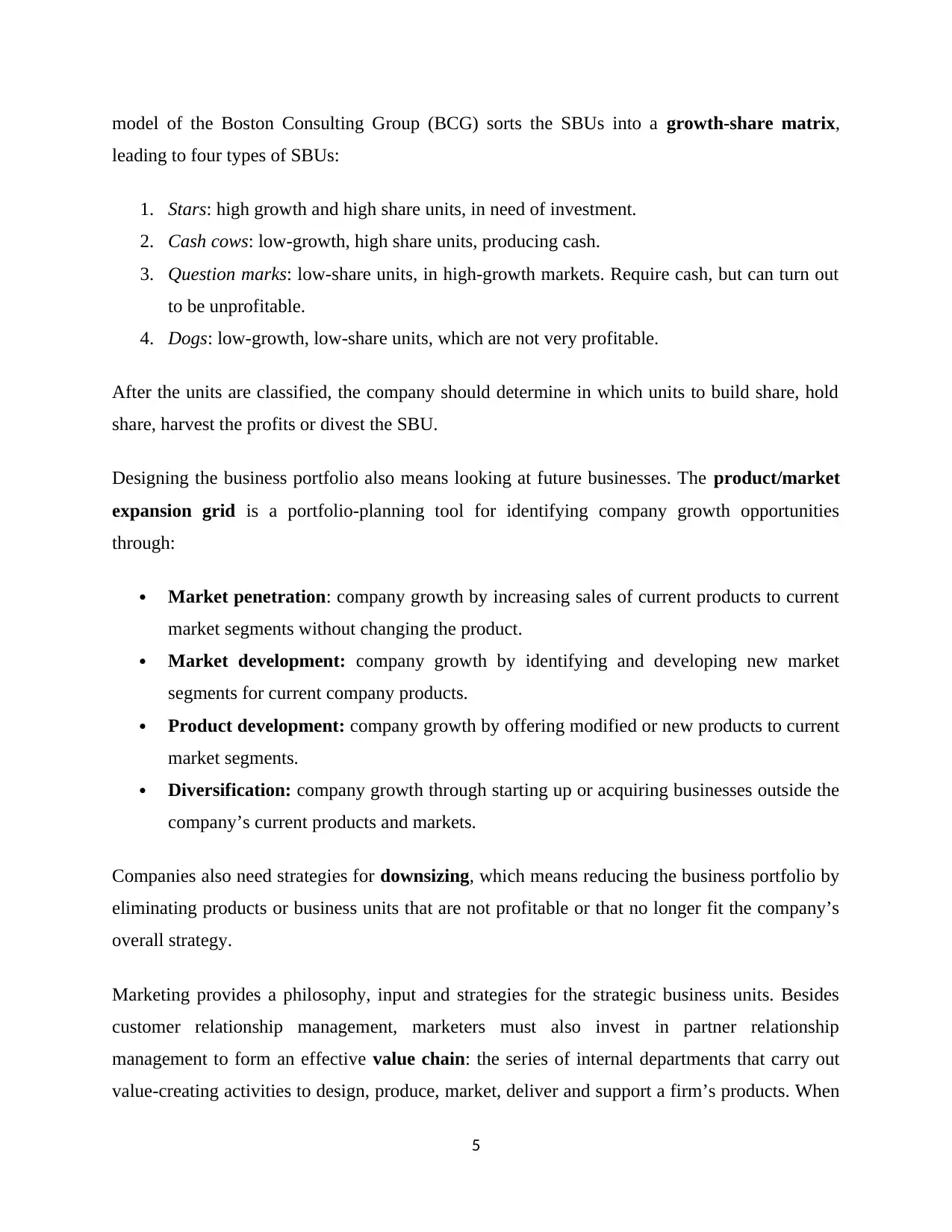
model of the Boston Consulting Group (BCG) sorts the SBUs into a growth-share matrix,
leading to four types of SBUs:
1. Stars: high growth and high share units, in need of investment.
2. Cash cows: low-growth, high share units, producing cash.
3. Question marks: low-share units, in high-growth markets. Require cash, but can turn out
to be unprofitable.
4. Dogs: low-growth, low-share units, which are not very profitable.
After the units are classified, the company should determine in which units to build share, hold
share, harvest the profits or divest the SBU.
Designing the business portfolio also means looking at future businesses. The product/market
expansion grid is a portfolio-planning tool for identifying company growth opportunities
through:
Market penetration: company growth by increasing sales of current products to current
market segments without changing the product.
Market development: company growth by identifying and developing new market
segments for current company products.
Product development: company growth by offering modified or new products to current
market segments.
Diversification: company growth through starting up or acquiring businesses outside the
company’s current products and markets.
Companies also need strategies for downsizing, which means reducing the business portfolio by
eliminating products or business units that are not profitable or that no longer fit the company’s
overall strategy.
Marketing provides a philosophy, input and strategies for the strategic business units. Besides
customer relationship management, marketers must also invest in partner relationship
management to form an effective value chain: the series of internal departments that carry out
value-creating activities to design, produce, market, deliver and support a firm’s products. When
5
leading to four types of SBUs:
1. Stars: high growth and high share units, in need of investment.
2. Cash cows: low-growth, high share units, producing cash.
3. Question marks: low-share units, in high-growth markets. Require cash, but can turn out
to be unprofitable.
4. Dogs: low-growth, low-share units, which are not very profitable.
After the units are classified, the company should determine in which units to build share, hold
share, harvest the profits or divest the SBU.
Designing the business portfolio also means looking at future businesses. The product/market
expansion grid is a portfolio-planning tool for identifying company growth opportunities
through:
Market penetration: company growth by increasing sales of current products to current
market segments without changing the product.
Market development: company growth by identifying and developing new market
segments for current company products.
Product development: company growth by offering modified or new products to current
market segments.
Diversification: company growth through starting up or acquiring businesses outside the
company’s current products and markets.
Companies also need strategies for downsizing, which means reducing the business portfolio by
eliminating products or business units that are not profitable or that no longer fit the company’s
overall strategy.
Marketing provides a philosophy, input and strategies for the strategic business units. Besides
customer relationship management, marketers must also invest in partner relationship
management to form an effective value chain: the series of internal departments that carry out
value-creating activities to design, produce, market, deliver and support a firm’s products. When
5
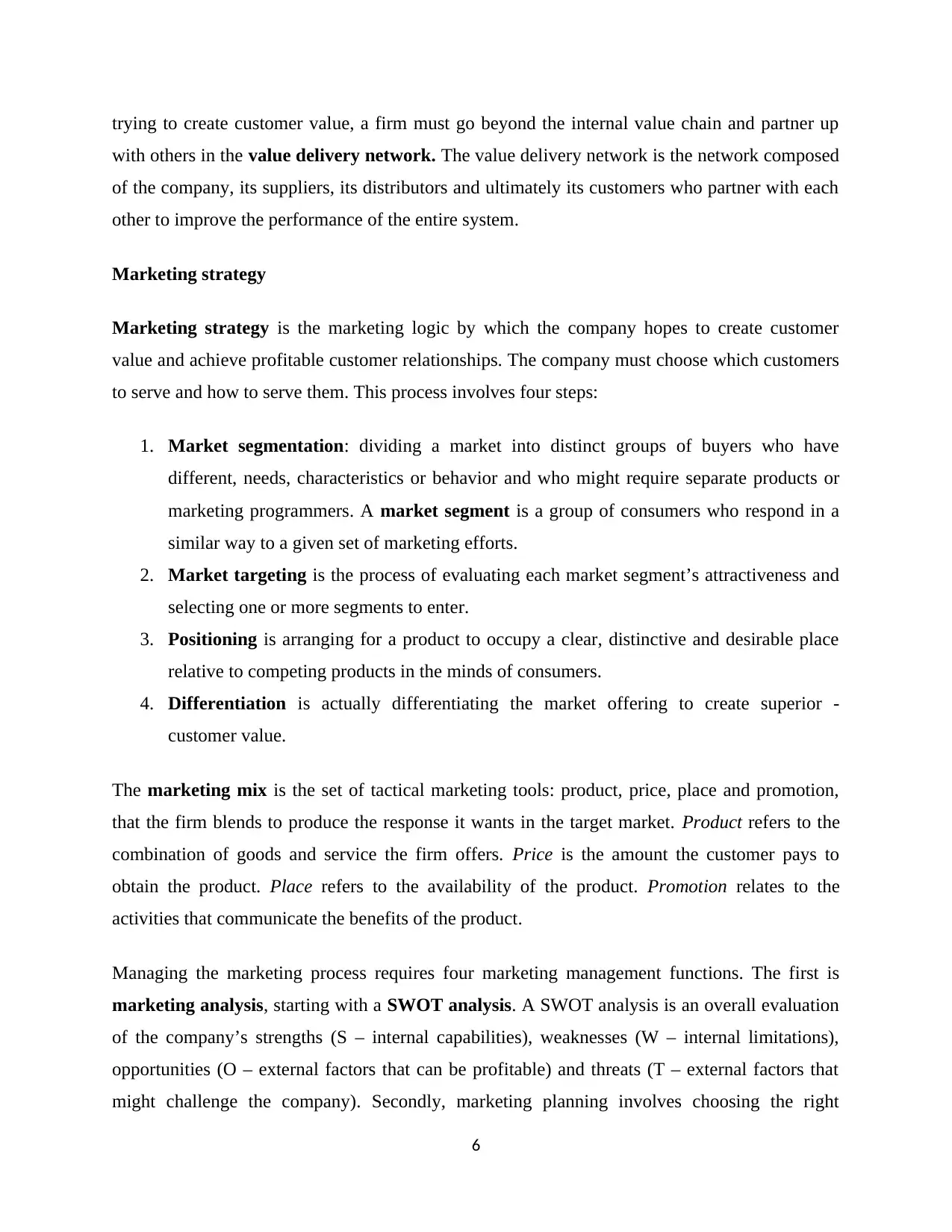
trying to create customer value, a firm must go beyond the internal value chain and partner up
with others in the value delivery network. The value delivery network is the network composed
of the company, its suppliers, its distributors and ultimately its customers who partner with each
other to improve the performance of the entire system.
Marketing strategy
Marketing strategy is the marketing logic by which the company hopes to create customer
value and achieve profitable customer relationships. The company must choose which customers
to serve and how to serve them. This process involves four steps:
1. Market segmentation: dividing a market into distinct groups of buyers who have
different, needs, characteristics or behavior and who might require separate products or
marketing programmers. A market segment is a group of consumers who respond in a
similar way to a given set of marketing efforts.
2. Market targeting is the process of evaluating each market segment’s attractiveness and
selecting one or more segments to enter.
3. Positioning is arranging for a product to occupy a clear, distinctive and desirable place
relative to competing products in the minds of consumers.
4. Differentiation is actually differentiating the market offering to create superior -
customer value.
The marketing mix is the set of tactical marketing tools: product, price, place and promotion,
that the firm blends to produce the response it wants in the target market. Product refers to the
combination of goods and service the firm offers. Price is the amount the customer pays to
obtain the product. Place refers to the availability of the product. Promotion relates to the
activities that communicate the benefits of the product.
Managing the marketing process requires four marketing management functions. The first is
marketing analysis, starting with a SWOT analysis. A SWOT analysis is an overall evaluation
of the company’s strengths (S – internal capabilities), weaknesses (W – internal limitations),
opportunities (O – external factors that can be profitable) and threats (T – external factors that
might challenge the company). Secondly, marketing planning involves choosing the right
6
with others in the value delivery network. The value delivery network is the network composed
of the company, its suppliers, its distributors and ultimately its customers who partner with each
other to improve the performance of the entire system.
Marketing strategy
Marketing strategy is the marketing logic by which the company hopes to create customer
value and achieve profitable customer relationships. The company must choose which customers
to serve and how to serve them. This process involves four steps:
1. Market segmentation: dividing a market into distinct groups of buyers who have
different, needs, characteristics or behavior and who might require separate products or
marketing programmers. A market segment is a group of consumers who respond in a
similar way to a given set of marketing efforts.
2. Market targeting is the process of evaluating each market segment’s attractiveness and
selecting one or more segments to enter.
3. Positioning is arranging for a product to occupy a clear, distinctive and desirable place
relative to competing products in the minds of consumers.
4. Differentiation is actually differentiating the market offering to create superior -
customer value.
The marketing mix is the set of tactical marketing tools: product, price, place and promotion,
that the firm blends to produce the response it wants in the target market. Product refers to the
combination of goods and service the firm offers. Price is the amount the customer pays to
obtain the product. Place refers to the availability of the product. Promotion relates to the
activities that communicate the benefits of the product.
Managing the marketing process requires four marketing management functions. The first is
marketing analysis, starting with a SWOT analysis. A SWOT analysis is an overall evaluation
of the company’s strengths (S – internal capabilities), weaknesses (W – internal limitations),
opportunities (O – external factors that can be profitable) and threats (T – external factors that
might challenge the company). Secondly, marketing planning involves choosing the right
6
⊘ This is a preview!⊘
Do you want full access?
Subscribe today to unlock all pages.

Trusted by 1+ million students worldwide
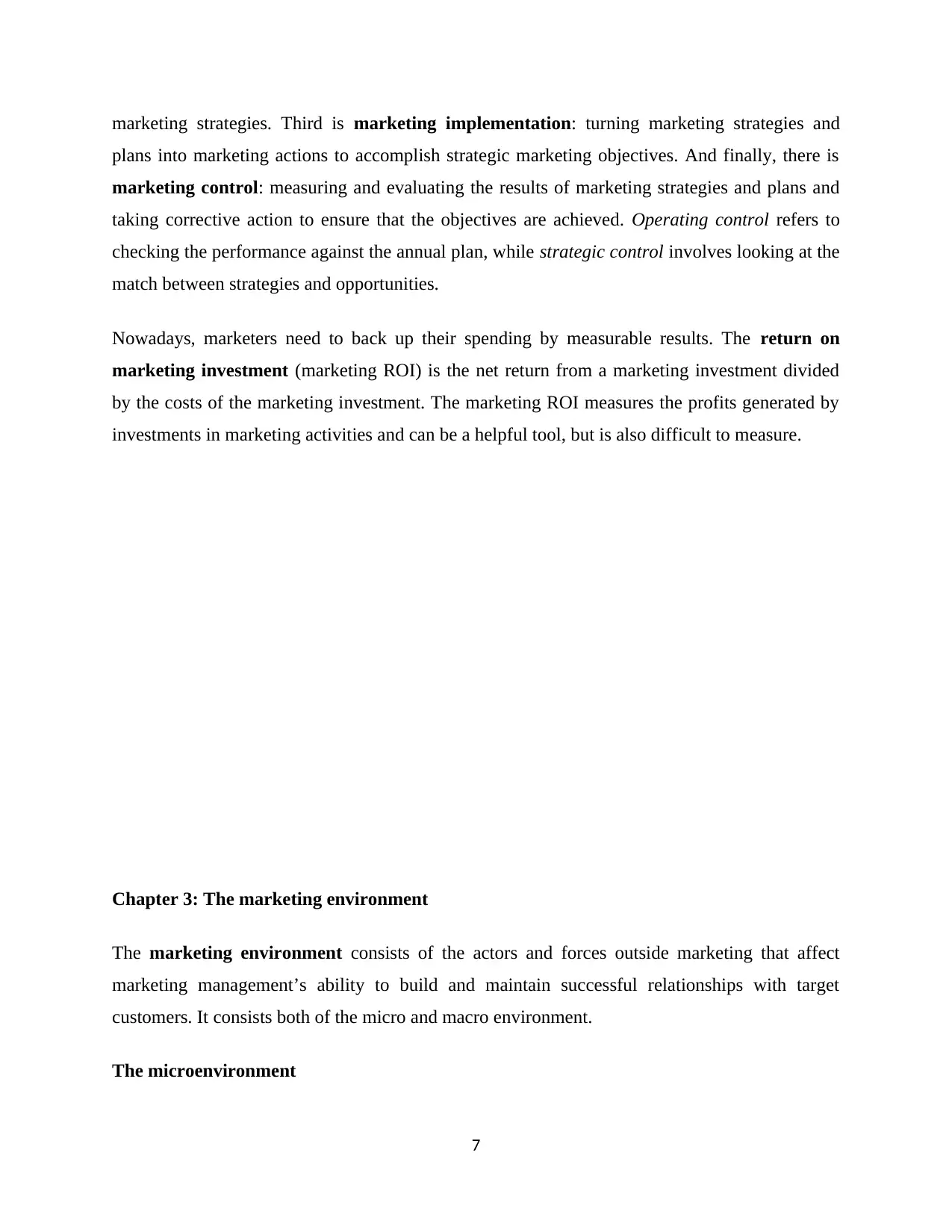
marketing strategies. Third is marketing implementation: turning marketing strategies and
plans into marketing actions to accomplish strategic marketing objectives. And finally, there is
marketing control: measuring and evaluating the results of marketing strategies and plans and
taking corrective action to ensure that the objectives are achieved. Operating control refers to
checking the performance against the annual plan, while strategic control involves looking at the
match between strategies and opportunities.
Nowadays, marketers need to back up their spending by measurable results. The return on
marketing investment (marketing ROI) is the net return from a marketing investment divided
by the costs of the marketing investment. The marketing ROI measures the profits generated by
investments in marketing activities and can be a helpful tool, but is also difficult to measure.
Chapter 3: The marketing environment
The marketing environment consists of the actors and forces outside marketing that affect
marketing management’s ability to build and maintain successful relationships with target
customers. It consists both of the micro and macro environment.
The microenvironment
7
plans into marketing actions to accomplish strategic marketing objectives. And finally, there is
marketing control: measuring and evaluating the results of marketing strategies and plans and
taking corrective action to ensure that the objectives are achieved. Operating control refers to
checking the performance against the annual plan, while strategic control involves looking at the
match between strategies and opportunities.
Nowadays, marketers need to back up their spending by measurable results. The return on
marketing investment (marketing ROI) is the net return from a marketing investment divided
by the costs of the marketing investment. The marketing ROI measures the profits generated by
investments in marketing activities and can be a helpful tool, but is also difficult to measure.
Chapter 3: The marketing environment
The marketing environment consists of the actors and forces outside marketing that affect
marketing management’s ability to build and maintain successful relationships with target
customers. It consists both of the micro and macro environment.
The microenvironment
7
Paraphrase This Document
Need a fresh take? Get an instant paraphrase of this document with our AI Paraphraser
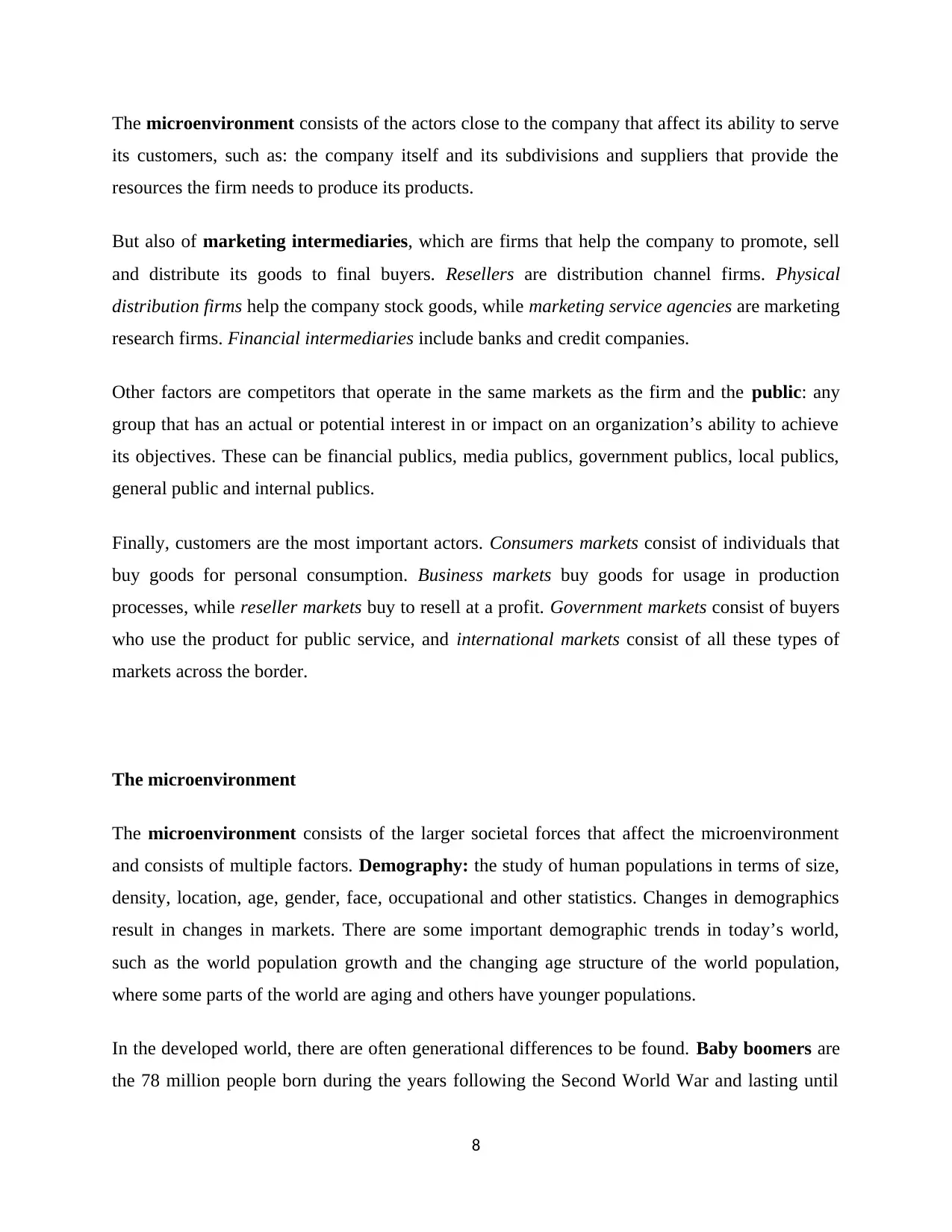
The microenvironment consists of the actors close to the company that affect its ability to serve
its customers, such as: the company itself and its subdivisions and suppliers that provide the
resources the firm needs to produce its products.
But also of marketing intermediaries, which are firms that help the company to promote, sell
and distribute its goods to final buyers. Resellers are distribution channel firms. Physical
distribution firms help the company stock goods, while marketing service agencies are marketing
research firms. Financial intermediaries include banks and credit companies.
Other factors are competitors that operate in the same markets as the firm and the public: any
group that has an actual or potential interest in or impact on an organization’s ability to achieve
its objectives. These can be financial publics, media publics, government publics, local publics,
general public and internal publics.
Finally, customers are the most important actors. Consumers markets consist of individuals that
buy goods for personal consumption. Business markets buy goods for usage in production
processes, while reseller markets buy to resell at a profit. Government markets consist of buyers
who use the product for public service, and international markets consist of all these types of
markets across the border.
The microenvironment
The microenvironment consists of the larger societal forces that affect the microenvironment
and consists of multiple factors. Demography: the study of human populations in terms of size,
density, location, age, gender, face, occupational and other statistics. Changes in demographics
result in changes in markets. There are some important demographic trends in today’s world,
such as the world population growth and the changing age structure of the world population,
where some parts of the world are aging and others have younger populations.
In the developed world, there are often generational differences to be found. Baby boomers are
the 78 million people born during the years following the Second World War and lasting until
8
its customers, such as: the company itself and its subdivisions and suppliers that provide the
resources the firm needs to produce its products.
But also of marketing intermediaries, which are firms that help the company to promote, sell
and distribute its goods to final buyers. Resellers are distribution channel firms. Physical
distribution firms help the company stock goods, while marketing service agencies are marketing
research firms. Financial intermediaries include banks and credit companies.
Other factors are competitors that operate in the same markets as the firm and the public: any
group that has an actual or potential interest in or impact on an organization’s ability to achieve
its objectives. These can be financial publics, media publics, government publics, local publics,
general public and internal publics.
Finally, customers are the most important actors. Consumers markets consist of individuals that
buy goods for personal consumption. Business markets buy goods for usage in production
processes, while reseller markets buy to resell at a profit. Government markets consist of buyers
who use the product for public service, and international markets consist of all these types of
markets across the border.
The microenvironment
The microenvironment consists of the larger societal forces that affect the microenvironment
and consists of multiple factors. Demography: the study of human populations in terms of size,
density, location, age, gender, face, occupational and other statistics. Changes in demographics
result in changes in markets. There are some important demographic trends in today’s world,
such as the world population growth and the changing age structure of the world population,
where some parts of the world are aging and others have younger populations.
In the developed world, there are often generational differences to be found. Baby boomers are
the 78 million people born during the years following the Second World War and lasting until
8
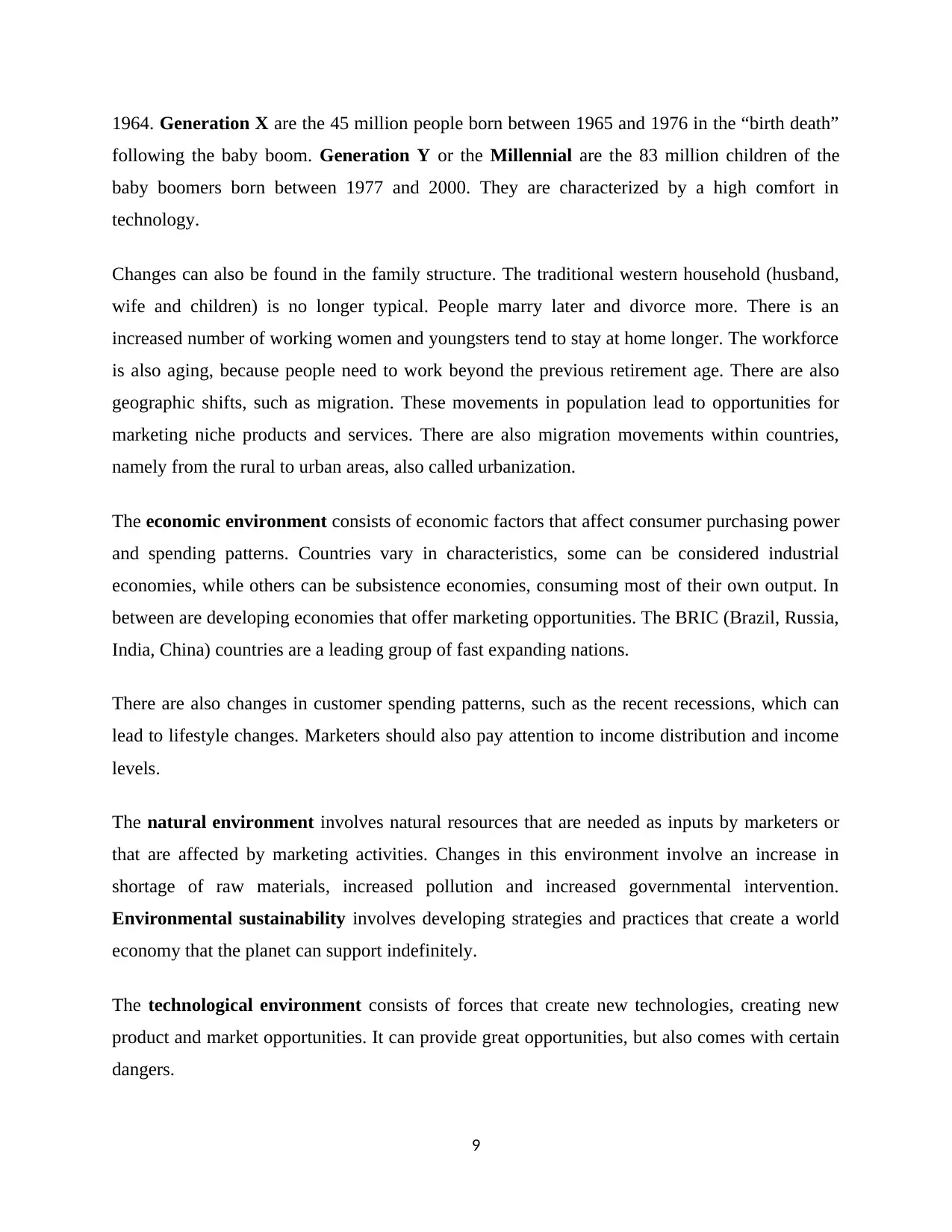
1964. Generation X are the 45 million people born between 1965 and 1976 in the “birth death”
following the baby boom. Generation Y or the Millennial are the 83 million children of the
baby boomers born between 1977 and 2000. They are characterized by a high comfort in
technology.
Changes can also be found in the family structure. The traditional western household (husband,
wife and children) is no longer typical. People marry later and divorce more. There is an
increased number of working women and youngsters tend to stay at home longer. The workforce
is also aging, because people need to work beyond the previous retirement age. There are also
geographic shifts, such as migration. These movements in population lead to opportunities for
marketing niche products and services. There are also migration movements within countries,
namely from the rural to urban areas, also called urbanization.
The economic environment consists of economic factors that affect consumer purchasing power
and spending patterns. Countries vary in characteristics, some can be considered industrial
economies, while others can be subsistence economies, consuming most of their own output. In
between are developing economies that offer marketing opportunities. The BRIC (Brazil, Russia,
India, China) countries are a leading group of fast expanding nations.
There are also changes in customer spending patterns, such as the recent recessions, which can
lead to lifestyle changes. Marketers should also pay attention to income distribution and income
levels.
The natural environment involves natural resources that are needed as inputs by marketers or
that are affected by marketing activities. Changes in this environment involve an increase in
shortage of raw materials, increased pollution and increased governmental intervention.
Environmental sustainability involves developing strategies and practices that create a world
economy that the planet can support indefinitely.
The technological environment consists of forces that create new technologies, creating new
product and market opportunities. It can provide great opportunities, but also comes with certain
dangers.
9
following the baby boom. Generation Y or the Millennial are the 83 million children of the
baby boomers born between 1977 and 2000. They are characterized by a high comfort in
technology.
Changes can also be found in the family structure. The traditional western household (husband,
wife and children) is no longer typical. People marry later and divorce more. There is an
increased number of working women and youngsters tend to stay at home longer. The workforce
is also aging, because people need to work beyond the previous retirement age. There are also
geographic shifts, such as migration. These movements in population lead to opportunities for
marketing niche products and services. There are also migration movements within countries,
namely from the rural to urban areas, also called urbanization.
The economic environment consists of economic factors that affect consumer purchasing power
and spending patterns. Countries vary in characteristics, some can be considered industrial
economies, while others can be subsistence economies, consuming most of their own output. In
between are developing economies that offer marketing opportunities. The BRIC (Brazil, Russia,
India, China) countries are a leading group of fast expanding nations.
There are also changes in customer spending patterns, such as the recent recessions, which can
lead to lifestyle changes. Marketers should also pay attention to income distribution and income
levels.
The natural environment involves natural resources that are needed as inputs by marketers or
that are affected by marketing activities. Changes in this environment involve an increase in
shortage of raw materials, increased pollution and increased governmental intervention.
Environmental sustainability involves developing strategies and practices that create a world
economy that the planet can support indefinitely.
The technological environment consists of forces that create new technologies, creating new
product and market opportunities. It can provide great opportunities, but also comes with certain
dangers.
9
⊘ This is a preview!⊘
Do you want full access?
Subscribe today to unlock all pages.

Trusted by 1+ million students worldwide
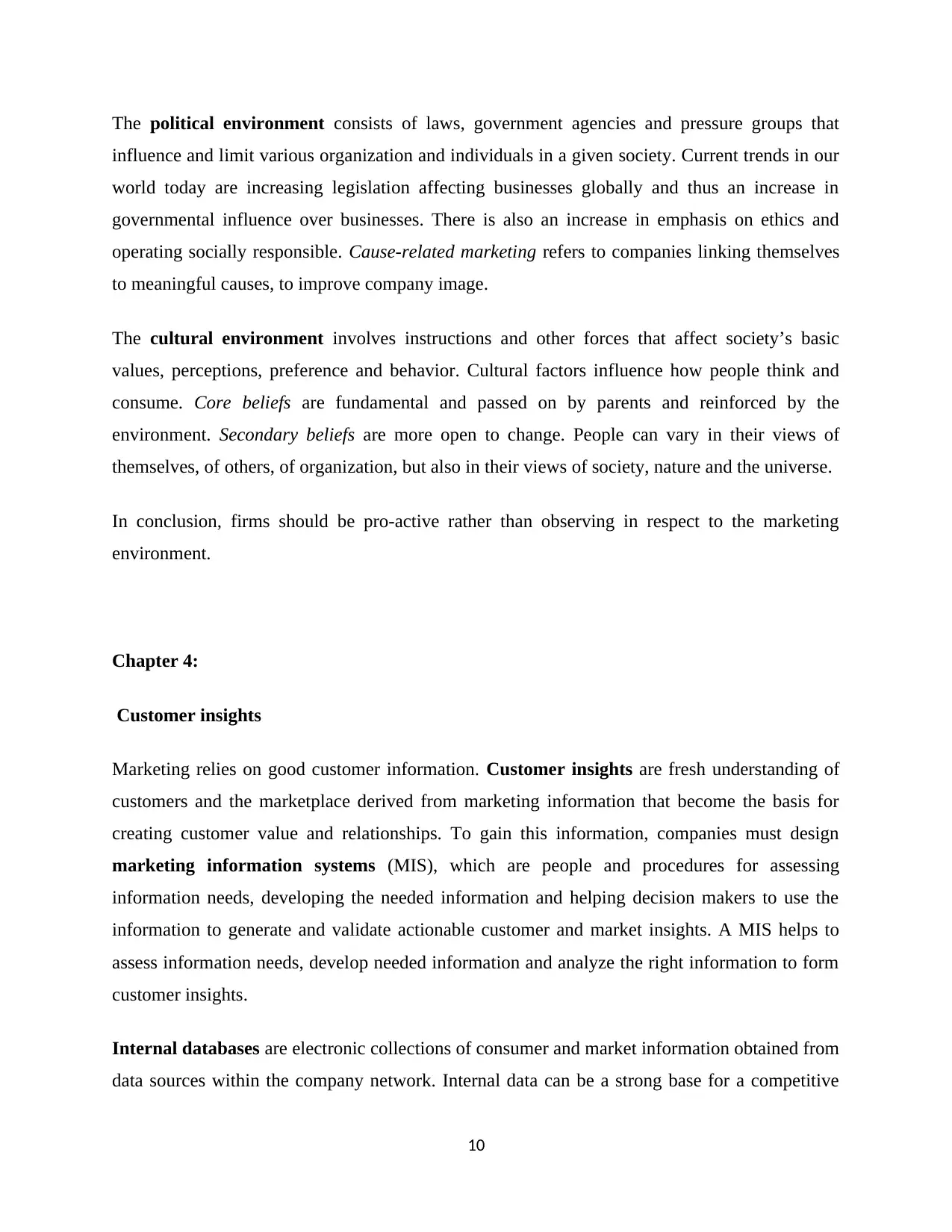
The political environment consists of laws, government agencies and pressure groups that
influence and limit various organization and individuals in a given society. Current trends in our
world today are increasing legislation affecting businesses globally and thus an increase in
governmental influence over businesses. There is also an increase in emphasis on ethics and
operating socially responsible. Cause-related marketing refers to companies linking themselves
to meaningful causes, to improve company image.
The cultural environment involves instructions and other forces that affect society’s basic
values, perceptions, preference and behavior. Cultural factors influence how people think and
consume. Core beliefs are fundamental and passed on by parents and reinforced by the
environment. Secondary beliefs are more open to change. People can vary in their views of
themselves, of others, of organization, but also in their views of society, nature and the universe.
In conclusion, firms should be pro-active rather than observing in respect to the marketing
environment.
Chapter 4:
Customer insights
Marketing relies on good customer information. Customer insights are fresh understanding of
customers and the marketplace derived from marketing information that become the basis for
creating customer value and relationships. To gain this information, companies must design
marketing information systems (MIS), which are people and procedures for assessing
information needs, developing the needed information and helping decision makers to use the
information to generate and validate actionable customer and market insights. A MIS helps to
assess information needs, develop needed information and analyze the right information to form
customer insights.
Internal databases are electronic collections of consumer and market information obtained from
data sources within the company network. Internal data can be a strong base for a competitive
10
influence and limit various organization and individuals in a given society. Current trends in our
world today are increasing legislation affecting businesses globally and thus an increase in
governmental influence over businesses. There is also an increase in emphasis on ethics and
operating socially responsible. Cause-related marketing refers to companies linking themselves
to meaningful causes, to improve company image.
The cultural environment involves instructions and other forces that affect society’s basic
values, perceptions, preference and behavior. Cultural factors influence how people think and
consume. Core beliefs are fundamental and passed on by parents and reinforced by the
environment. Secondary beliefs are more open to change. People can vary in their views of
themselves, of others, of organization, but also in their views of society, nature and the universe.
In conclusion, firms should be pro-active rather than observing in respect to the marketing
environment.
Chapter 4:
Customer insights
Marketing relies on good customer information. Customer insights are fresh understanding of
customers and the marketplace derived from marketing information that become the basis for
creating customer value and relationships. To gain this information, companies must design
marketing information systems (MIS), which are people and procedures for assessing
information needs, developing the needed information and helping decision makers to use the
information to generate and validate actionable customer and market insights. A MIS helps to
assess information needs, develop needed information and analyze the right information to form
customer insights.
Internal databases are electronic collections of consumer and market information obtained from
data sources within the company network. Internal data can be a strong base for a competitive
10
Paraphrase This Document
Need a fresh take? Get an instant paraphrase of this document with our AI Paraphraser
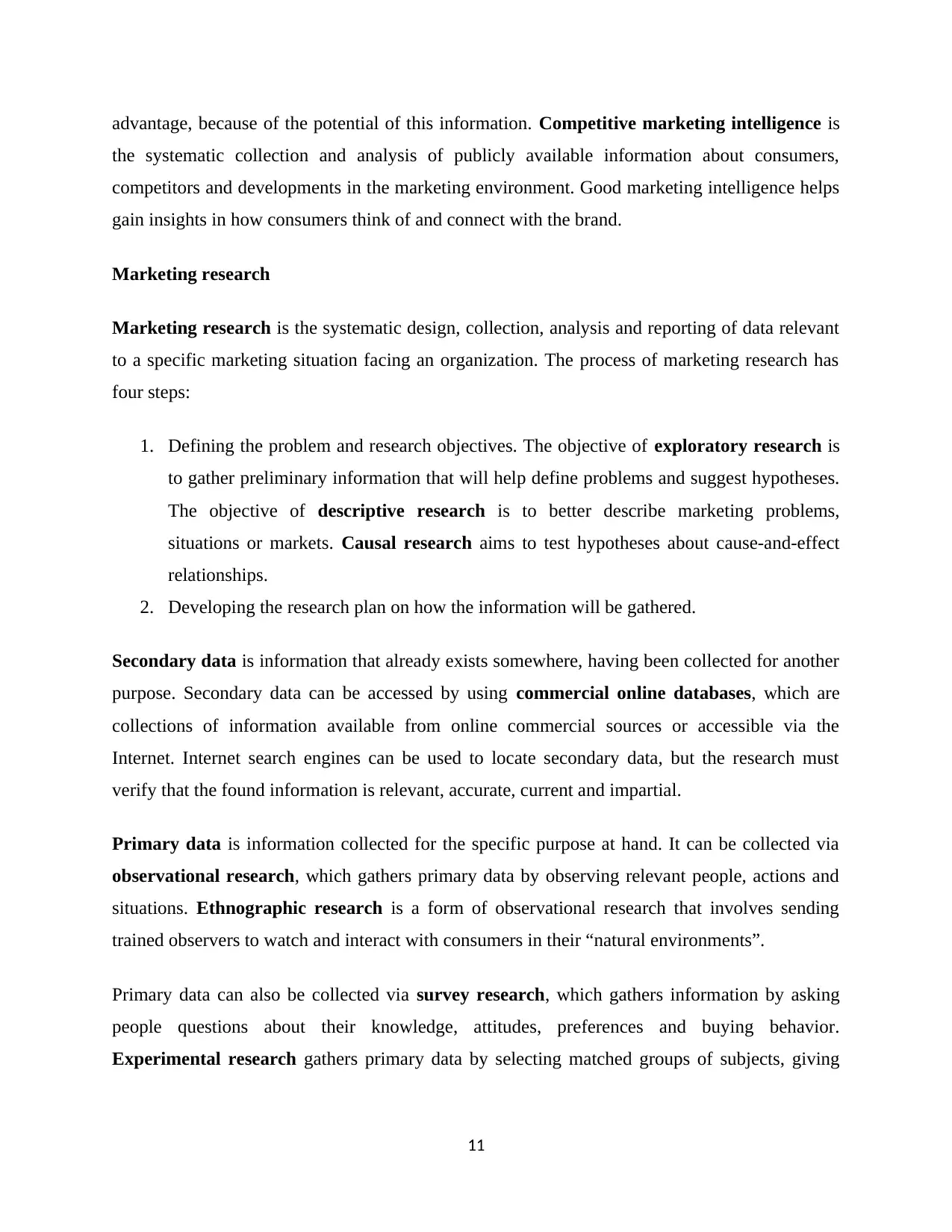
advantage, because of the potential of this information. Competitive marketing intelligence is
the systematic collection and analysis of publicly available information about consumers,
competitors and developments in the marketing environment. Good marketing intelligence helps
gain insights in how consumers think of and connect with the brand.
Marketing research
Marketing research is the systematic design, collection, analysis and reporting of data relevant
to a specific marketing situation facing an organization. The process of marketing research has
four steps:
1. Defining the problem and research objectives. The objective of exploratory research is
to gather preliminary information that will help define problems and suggest hypotheses.
The objective of descriptive research is to better describe marketing problems,
situations or markets. Causal research aims to test hypotheses about cause-and-effect
relationships.
2. Developing the research plan on how the information will be gathered.
Secondary data is information that already exists somewhere, having been collected for another
purpose. Secondary data can be accessed by using commercial online databases, which are
collections of information available from online commercial sources or accessible via the
Internet. Internet search engines can be used to locate secondary data, but the research must
verify that the found information is relevant, accurate, current and impartial.
Primary data is information collected for the specific purpose at hand. It can be collected via
observational research, which gathers primary data by observing relevant people, actions and
situations. Ethnographic research is a form of observational research that involves sending
trained observers to watch and interact with consumers in their “natural environments”.
Primary data can also be collected via survey research, which gathers information by asking
people questions about their knowledge, attitudes, preferences and buying behavior.
Experimental research gathers primary data by selecting matched groups of subjects, giving
11
the systematic collection and analysis of publicly available information about consumers,
competitors and developments in the marketing environment. Good marketing intelligence helps
gain insights in how consumers think of and connect with the brand.
Marketing research
Marketing research is the systematic design, collection, analysis and reporting of data relevant
to a specific marketing situation facing an organization. The process of marketing research has
four steps:
1. Defining the problem and research objectives. The objective of exploratory research is
to gather preliminary information that will help define problems and suggest hypotheses.
The objective of descriptive research is to better describe marketing problems,
situations or markets. Causal research aims to test hypotheses about cause-and-effect
relationships.
2. Developing the research plan on how the information will be gathered.
Secondary data is information that already exists somewhere, having been collected for another
purpose. Secondary data can be accessed by using commercial online databases, which are
collections of information available from online commercial sources or accessible via the
Internet. Internet search engines can be used to locate secondary data, but the research must
verify that the found information is relevant, accurate, current and impartial.
Primary data is information collected for the specific purpose at hand. It can be collected via
observational research, which gathers primary data by observing relevant people, actions and
situations. Ethnographic research is a form of observational research that involves sending
trained observers to watch and interact with consumers in their “natural environments”.
Primary data can also be collected via survey research, which gathers information by asking
people questions about their knowledge, attitudes, preferences and buying behavior.
Experimental research gathers primary data by selecting matched groups of subjects, giving
11
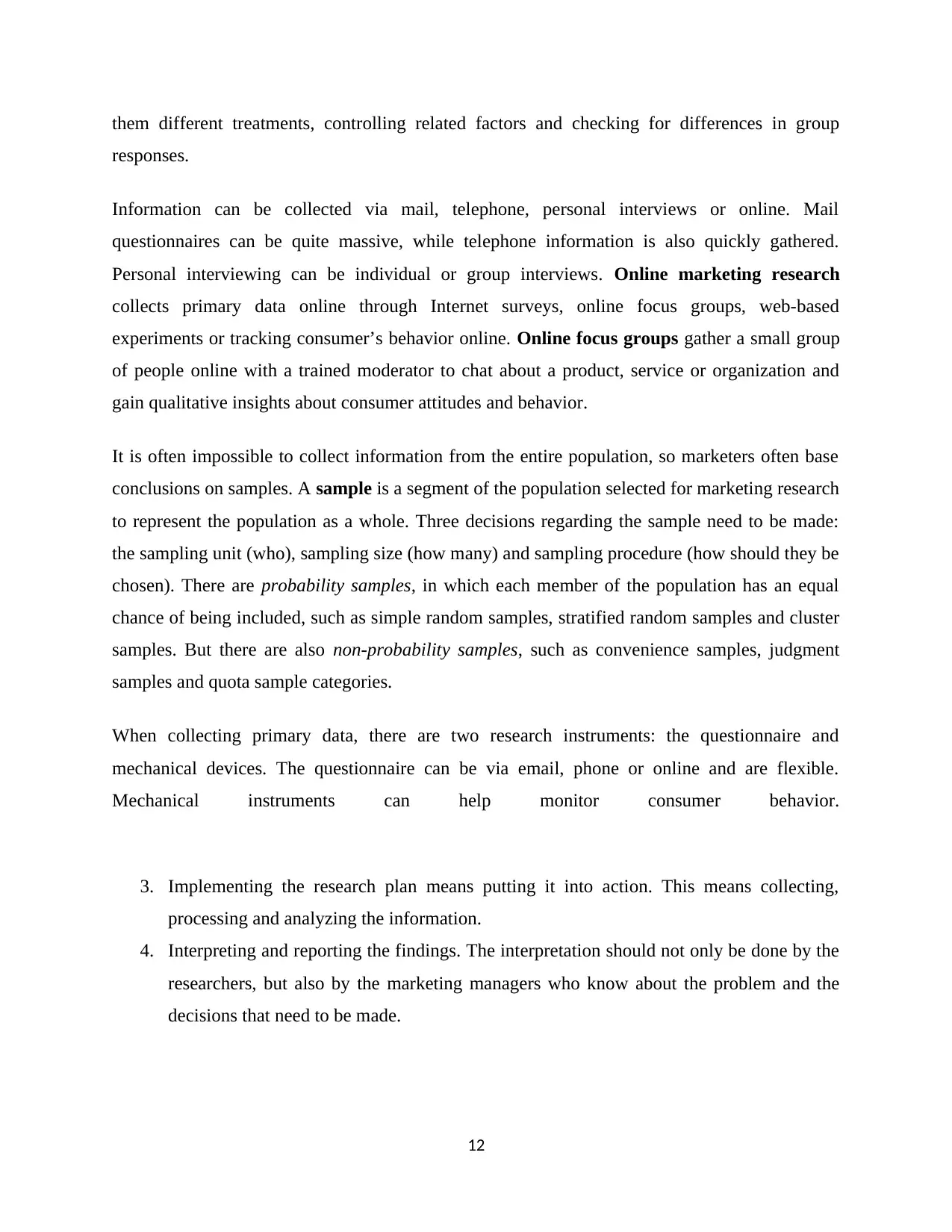
them different treatments, controlling related factors and checking for differences in group
responses.
Information can be collected via mail, telephone, personal interviews or online. Mail
questionnaires can be quite massive, while telephone information is also quickly gathered.
Personal interviewing can be individual or group interviews. Online marketing research
collects primary data online through Internet surveys, online focus groups, web-based
experiments or tracking consumer’s behavior online. Online focus groups gather a small group
of people online with a trained moderator to chat about a product, service or organization and
gain qualitative insights about consumer attitudes and behavior.
It is often impossible to collect information from the entire population, so marketers often base
conclusions on samples. A sample is a segment of the population selected for marketing research
to represent the population as a whole. Three decisions regarding the sample need to be made:
the sampling unit (who), sampling size (how many) and sampling procedure (how should they be
chosen). There are probability samples, in which each member of the population has an equal
chance of being included, such as simple random samples, stratified random samples and cluster
samples. But there are also non-probability samples, such as convenience samples, judgment
samples and quota sample categories.
When collecting primary data, there are two research instruments: the questionnaire and
mechanical devices. The questionnaire can be via email, phone or online and are flexible.
Mechanical instruments can help monitor consumer behavior.
3. Implementing the research plan means putting it into action. This means collecting,
processing and analyzing the information.
4. Interpreting and reporting the findings. The interpretation should not only be done by the
researchers, but also by the marketing managers who know about the problem and the
decisions that need to be made.
12
responses.
Information can be collected via mail, telephone, personal interviews or online. Mail
questionnaires can be quite massive, while telephone information is also quickly gathered.
Personal interviewing can be individual or group interviews. Online marketing research
collects primary data online through Internet surveys, online focus groups, web-based
experiments or tracking consumer’s behavior online. Online focus groups gather a small group
of people online with a trained moderator to chat about a product, service or organization and
gain qualitative insights about consumer attitudes and behavior.
It is often impossible to collect information from the entire population, so marketers often base
conclusions on samples. A sample is a segment of the population selected for marketing research
to represent the population as a whole. Three decisions regarding the sample need to be made:
the sampling unit (who), sampling size (how many) and sampling procedure (how should they be
chosen). There are probability samples, in which each member of the population has an equal
chance of being included, such as simple random samples, stratified random samples and cluster
samples. But there are also non-probability samples, such as convenience samples, judgment
samples and quota sample categories.
When collecting primary data, there are two research instruments: the questionnaire and
mechanical devices. The questionnaire can be via email, phone or online and are flexible.
Mechanical instruments can help monitor consumer behavior.
3. Implementing the research plan means putting it into action. This means collecting,
processing and analyzing the information.
4. Interpreting and reporting the findings. The interpretation should not only be done by the
researchers, but also by the marketing managers who know about the problem and the
decisions that need to be made.
12
⊘ This is a preview!⊘
Do you want full access?
Subscribe today to unlock all pages.

Trusted by 1+ million students worldwide
1 out of 68
Related Documents
Your All-in-One AI-Powered Toolkit for Academic Success.
+13062052269
info@desklib.com
Available 24*7 on WhatsApp / Email
![[object Object]](/_next/static/media/star-bottom.7253800d.svg)
Unlock your academic potential
Copyright © 2020–2025 A2Z Services. All Rights Reserved. Developed and managed by ZUCOL.





